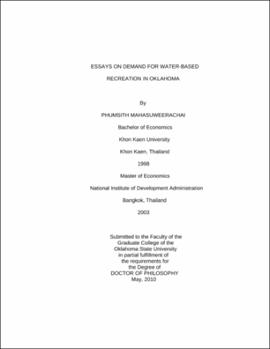| dc.contributor.advisor | Boyer, Tracy Ann | |
| dc.contributor.author | Mahasuweerachai, Phumsith | |
| dc.date.accessioned | 2013-11-26T08:22:02Z | |
| dc.date.available | 2013-11-26T08:22:02Z | |
| dc.date.issued | 2010-05 | |
| dc.identifier.uri | https://hdl.handle.net/11244/6523 | |
| dc.description.abstract | Scope, Method of Study, and Findings: Even though the demand for lake recreation in Oklahoma has increased continuously since the 1950s, few recent studies have analyzed the demand for lake recreation as well as their welfare effects from lake use in term of recreation. This study proposes to explore what factors influence lake recreation demand and how changes in these factors affect Oklahoma lake recreationists. Discrete choice analysis and travel cost techniques are applied in this study. | |
| dc.description.abstract | The first essay explores the benefit gained from combining revealed and stated preferences data (RP and SP data) to explain and predict current and future behavior of lake recreationists. Overall, this study found that the model that uses RP and SP data together provides the best explanation and prediction of lake recreationists' current and future behavior. | |
| dc.description.abstract | In addition, the second paper also develops a linked site choice model that combines current and potential lake recreationists' data to calculate the annual welfare changes due to lake quality changes. The idea of this essay is that new lake users attracted by improvements in lake quality should be included in estimating recreational demands because some current non-users could be attracted by higher lake quality. Failure to include this group of people results in biased annual welfare estimates. This study found that the model that pools current and potential lake recreationists' data provides significant larger annual welfare estimates than that which estimates from current lake users only. Furthermore, the combined current and potential lake user model can also capture the annual welfare changes from potential lake recreationists, which cannot be generated by the model that uses only current lake user data. | |
| dc.description.abstract | The third and final essay of this study focuses on anglers' preferences for the Close-to-Home-Fishing Program (CTHFP). Generally, anglers are willing to pay for increases in management effort such as larger stocked catfish and increased variety in fish stocked in the CTHFP ponds. However, relatively speaking, anglers are more willing to pay more for physical amenities such as fishing docks and restroom facilities. | |
| dc.format | application/pdf | |
| dc.language | en_US | |
| dc.rights | Copyright is held by the author who has granted the Oklahoma State University Library the non-exclusive right to share this material in its institutional repository. Contact Digital Library Services at lib-dls@okstate.edu or 405-744-9161 for the permission policy on the use, reproduction or distribution of this material. | |
| dc.title | Essays on demand for water-based recreation in Oklahoma | |
| dc.contributor.committeeMember | Sanders, Larry D. | |
| dc.contributor.committeeMember | Lusk, Jayson | |
| dc.contributor.committeeMember | Whitacre, Brian | |
| dc.contributor.committeeMember | Caneday, Lowell | |
| osu.filename | Mahasuweerachai_okstate_0664D_10866 | |
| osu.accesstype | Open Access | |
| dc.type.genre | Dissertation | |
| dc.type.material | Text | |
| dc.subject.keywords | combined rp and sp data | |
| dc.subject.keywords | discrete choice analysis | |
| dc.subject.keywords | lake recreation | |
| dc.subject.keywords | non-market valuation | |
| dc.subject.keywords | water clarity | |
| thesis.degree.discipline | Agricultural Economics | |
| thesis.degree.grantor | Oklahoma State University | |
